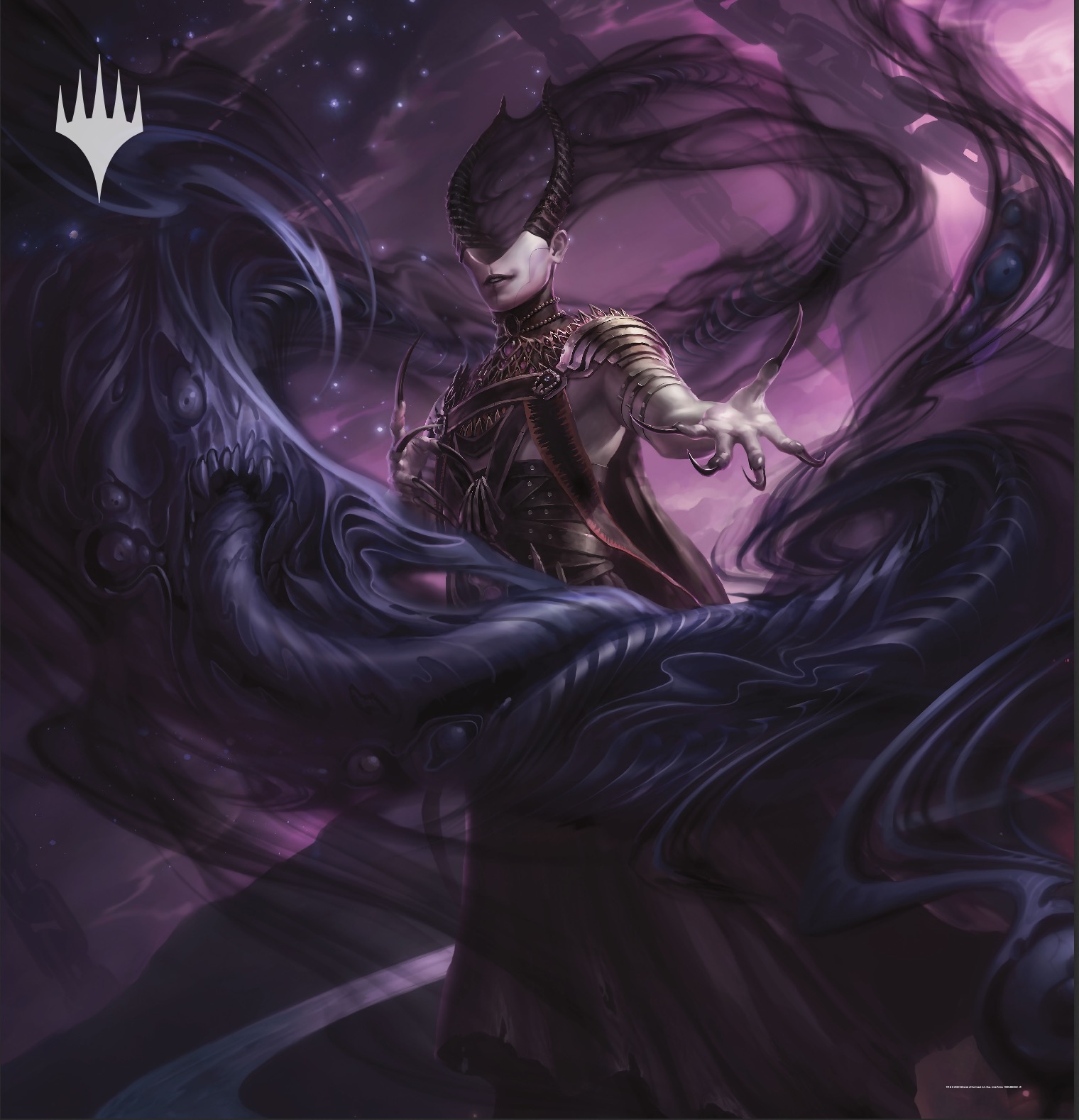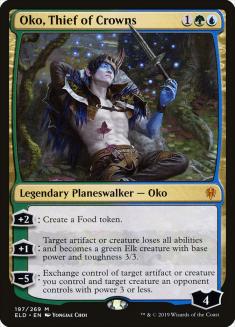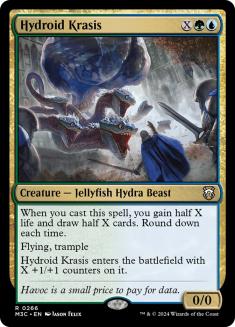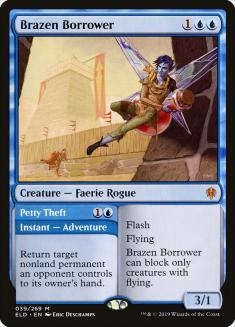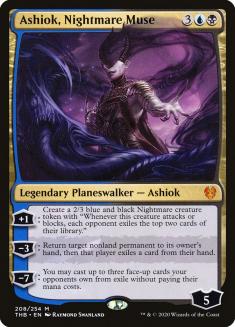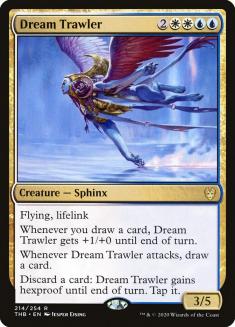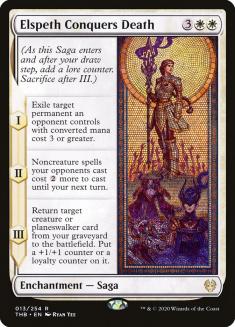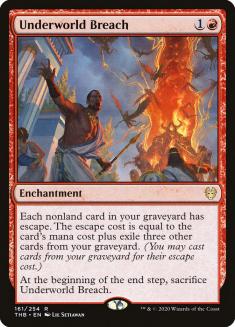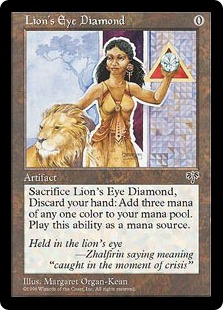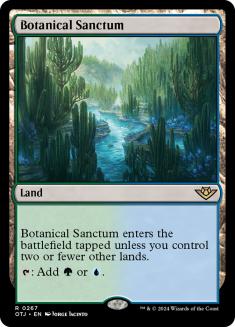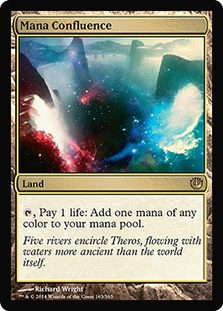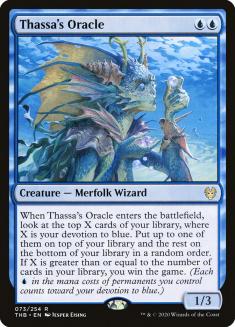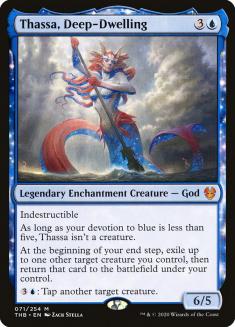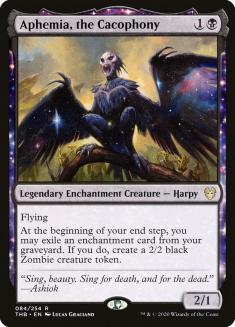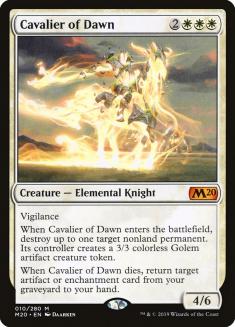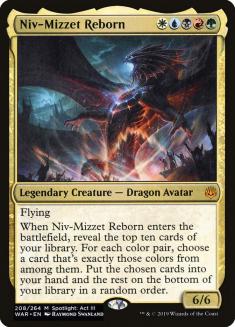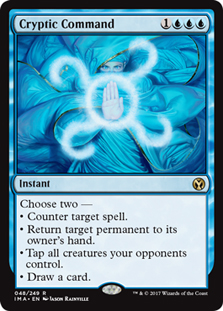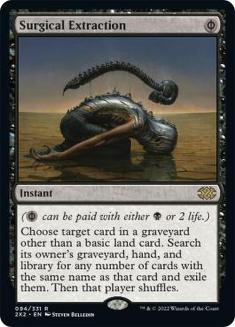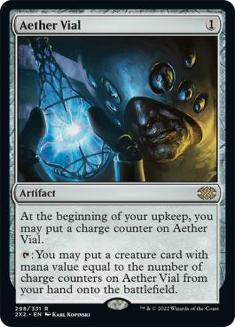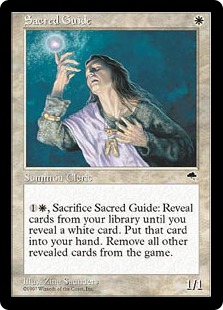When I made my Magic finance New Year’s resolutions back in late December, I declared that one of my biggest goals for 2020 would be to spend more time digging into early trends and making bold calls during the first few weeks the next Standard environment.
This is a big change from how I used to operate. Back when I first started writing this column a decade ago, it was better to be patient. The right call was to let the hype die down, see what the pros picked up on the third or fourth week after a set release, and then figure out what to buy. That simply isn’t true anymore. Thanks to the proliferation of excellent Magic content and Arena’s ability to let people churn through dozens of matches a day, future format staples rarely fly under the radar for long these days. Over the past year, standout cards like Oko, Thief of Crowns; Hydroid Krasis; and Teferi, Time Raveler made their presence known right away. If you’d waited until the third or fourth weeks to buy into those respective formats, you’d have been forced to pay for your staples at the absolute top of the market.
We all know that Magic finance is primarily about buying low and selling high, but the week after a set is released is one of the few times when buying high and selling low can actually be the correct call. For example, Oko, Thief of Crowns jumped from $25 to $35 the week after Throne of Eldrane was released, but “buying high” on Oko would have still seemed like a bargain once his price tag shot past $60 a few weeks later. Ditto for Hydroid Krasis — the card pre-ordered for $15, but even buying in at its Week 1 price tag of $30 would have been correct. Teferi, Time Raveler still hasn’t spent much time above that mark, but it’s been one of the best, most stable holds in the entire game over the past year. I doubt that anyone who bought Teferis when War of the Spark was released is currently regretting their purchase.
The other benefit of buying high right now is that you can take advantage of inflated prices on the other Theros Beyond Death cards that are still expensive primarily due to pre-order hype. One of the quirks of Magic finance is that hot new cards tend to shoot up in price very quickly, while potential busts take a while to settle down into their eventual ruts. The earlier you learn to separate the wheat from the chaff in a given set, the more you can take advantage of this by trading or selling the stuff that’s unlikely to pay off while doubling down on future format staples.
Of course, there’s no way we can hope to get everything right this early in a set’s lifespan. Some future staples still won’t make their presence known for weeks, or even months. For example, even though Oko, Thief of Crowns made an immediate splash across multiple formats, Brazen Borrower did the opposite. Instead of spiking early, the blue mythic followed a pretty standard “bust” curve, dropping a few dollars each week before bottoming out in mid-November. Only then did it start to catch on, especially in eternal formats. Now, Brazen Borrower might well be the most important card in all of Throne of Eldrane.
Theros Beyond Death cards will also spike and drop in the months to come as formats shift and evolve. There’s no accounting for that right now, either. The Core Set 2020 Cavaliers didn’t do much until Fires of Invention was released, while Sorin, Imperious Bloodlord dominated Core Set 2020 Standard in late August before falling off after rotation. The value of Magic cards is always contextual, and that context is constantly shifting.
So yeah. There’s no way to know which cards are going to be good six months from now, but current value is always going to be the best predictor of future value. In other words, a card that’s proving itself to be good right now is far more likely to be good in the future than a card that hasn’t proven itself at all.
That’s why today’s column is so important. When I last wrote about Theros Beyond Death, none of us had played a single game of Theros Beyond Death Standard. Our discussion was entirely theoretical, based on the text of the cards and nothing else. But even though there haven’t been a lot of high-profile Standard tournaments just yet, innovation has already started to happen on Magic Online (MTGO) and Arena. The difference between looking at a card in a vacuum and looking at how it has performed in a 5-0 deck is pretty big, and it’s worth taking a deep dive into the results we have gotten so far.
That’s our goal for today. Let’s see if we can solve Theros Beyond Death finance before everyone else, allowing us to fill our collection with the Theros Beyond Death cards that are most likely to hold their value for the rest of the year. I’d like to begin with a planeswalker that is quickly becoming my favorite mythic in the set:
Ashiok, Nightmare Muse
Ashiok, Nightmare Muse has quickly proven itself the standout planeswalker in Theros Beyond Death. Both Calix, Destiny’s Hand and Elspeth, Sun’s Nemesis have underperformed so far, with Elspeth looking like she might end up going down as one of the biggest disappointments in the entire set. I tend to agree with Andrew Elenbogen and his take on that card — ten years ago, Elspeth, Sun’s Nemesis might have been the most impactful card in all of Standard. Today, she’s unlikely to make a peep.
That makes Ashiok even more interesting. All that Theros Beyond Death value has to go somewhere, and if it’s not going into Elspeth or Calix, perhaps we’ll end up with Ashiok, Nightmare Muse spiking toward $50. Most sets tend to have at least one marquee planeswalker, after all, and Ashiok is by far the most likely planeswalker in Theros Beyond Death to get there.
So far, however, Ashiok reminds me more of second-tier planeswalkers like Vraska, Golgari Queen than multi-format all-stars like Teferi, Time Raveler and Oko, Thief of Crowns. Ashiok doesn’t seem like the kind of card that’s going to warp the metagame around it. Heck, it doesn’t even seem like the kind of card that you necessarily want four copies of in your deck. But it has started showing up all over the place on Arena, and it tends to look great whenever it’s on the battlefield. That should be enough to keep demand — and price tag — up.
Consider the following 5-0 deck from a MTGO event late last week:
Creatures (11)
Planeswalkers (6)
Lands (26)
Spells (17)
Sideboard

This deck does a great job showcasing Ashiok’s power in an Esper shell, surrounded by several other exciting new cards that we’ll get to a little bit later. I’ve also seen Ashiok starting to show up here and there in Dimir Control decks in both Standard and Pioneer, which speaks to its high overall power level. If there’s room for any sort of Esper or Dimir deck in the new metagame’s top tier — a likely occurrence, in my estimation — then Ashiok will almost certainly be playing a part. I’d buy in now.
Dream Trawler
Speaking of control cards, Dream Trawler is quickly proving itself to be one of the set’s breakout rares. I was far lower on the card than I should have been in my set review, mostly because of its prohibitive casting cost. 2WWUU is hard to pull off, and I figured that Azorius Control would be Dream Trawler’s only real shot to see competitive play. With so many exciting Esper and Jeskai decks floating around the format, that wasn’t a gamble that seemed worth taking at the time.
I was wrong. Once I actually started playing with Dream Trawler, I realized why decks like Esper Hero are willing to roll with the Sphinx regardless of how hard it is to cast. Even more importantly, it looks like Dream Trawler is starting to show up in Jeskai Fires. The Fires deck that 5-0’ed the same event last week ran two copies of Dream Trawler, and the card has a pretty high ceiling if it actually ends up being a Fires staple as well as a role-player in various Azorius and Esper brews.
You should take this innovation with a grain of salt — I haven’t seen a lot of Jeskai Fires decks adopting this tech yet — but it speaks to the kind of multi-deck upside that Dream Trawler possesses. Everyone wants to fit this into their deck if possible because of how quickly the game can get out of hand if you can actually stick one of these, and its future looks incredibly bright. Pick your set up ASAP.
Elspeth Conquers Death
I haven’t seen much hype surrounding Elspeth Conquers Death yet, and its price hasn’t really budged since the start of the pre-order period. Both Ashiok and Dream Drawler saw price increases last week, but Elspeth Conquers Death continues to fly under the radar.
Why bring the card up at all? Because Elspeth Conquers Death has quickly proven itself one of the most powerful Standard cards in the set. It’s probably going to be relegated to sideboards in the current metagame, but demand should increase over time. It’s the sort of card that rarely ends up being worth more than $5, but you’ll still want to have a playset in your toolbox. Get your set now, before people realize that Elspeth Conquers Death is a Standard staple.
Underworld Breach
Not everything has to be a surprise. Sometimes, the most obvious potential outcome ends up being true. Underworld Breach looked impossibly powerful the moment I saw it. Then I played with it, and guess what? Underworld Breach is, in fact, impossibly powerful.
I expected Underworld Breach to make an impact in Legacy, and I’ve been proven right on that count so far. Granted, Legacy demand doesn’t really move markets these days, but I don’t think we’ve even begun to scratch the surface of what’s possible here. It’s possible that we’re looking at the most important Legacy card of the year, full stop.
Whether Underworld Breach ends up being amazing or merely very good in Legacy, players are going to want to try these decks out. Unfortunately, all the lists I’ve seen so far have a pretty serious bottleneck: Lion’s Eye Diamond. This Reserved List staple currently sells for a whopping $220, and it’s hard to justify dropping almost $900 on a playset when Legacy events are few and far between these days.
Regardless, it’s quite possible that Underworld Breach could still lead to a Lion’s Eye Diamond spike. The card has been as high as $300 in the recent past, and it’s about to become a prerequisite for Legacy’s hottest new deck. This isn’t a spec for folks with light wallets, but if you’ve been on the fence about buying Diamonds for a while, this might be your last opportunity for the foreseeable future.
I wasn’t surprised to see Underworld Breach making waves in Legacy, but I was a little shocked to see how well it has been performing in Pioneer. Underworld Breach has become the basis for a brand new combo deck over the past few days, and I feel like the sky is the limit in Magic’s newest eternal format as well:
Creatures (5)
Lands (24)
Spells (31)
- 4 Sylvan Scrying
- 4 Strategic Planning
- 4 Chronic Flooding
- 4 Hidden Strings
- 3 Dig Through Time
- 4 Pore Over the Pages
- 4 Wolfwillow Haven
- 4 Underworld Breach
Sideboard

Whether or not Temur Breach ends up in Pioneer’s top tier, folks are going to want to try it out. Magic players love a good combo deck, and Temur Breach is actually pretty cheap to build — the most expensive cards in it are Botanical Sanctum, Mana Confluence, and Lotus Field. All of these cards have some nice financial upside right now, but Lotus Field seems likely to end up as the deck’s signature card. It’s a key part of the combo, and its price chart looks like it’s right on the cusp of spiking. If you don’t have a set of those yet, I’d snag them ASAP.
I’m also going to make sure that I have a set of Underworld Breaches in my collection sooner rather than later. It hasn’t really spiked since the pre-order period, but it’s going to end up seeing loads of play across all formats, including Commander. If it isn’t banned or reprinted, Underworld Breach is the kind of card that’ll end up being an easy $10-$15 in a couple of years. Get your set now.
Thassa’s Oracle
Thassa’s Oracle is another powerful Theros Beyond Death card that made an immediate impact in eternal Magic. In fact, it has been showing up as a win condition in a lot of the same Legacy decks that are now running Underworld Breach. Its upside goes beyond that, though, as folks are testing Thassa’s Oracle in Modern Storm and several combo variants in Pioneer that are too new to even have names yet.
I’m also excited about Thassa’s Oracle in non-combo contexts. Mono-Blue Devotion is still a fringe deck in Pioneer, but Thassa’s Oracle is quite the powerful addition. In fact, I’ve seen a few decks running around on MTGO that have added four copies of the Merfolk to sweet lists like this:
Creatures (30)
- 4 Cloudfin Raptor
- 1 Tidebinder Mage
- 2 Thassa, God of the Sea
- 3 Master of Waves
- 4 Harbinger of the Tides
- 4 Siren Stormtamer
- 4 Merfolk Trickster
- 4 Tempest Djinn
- 2 Gadwick, the Wizened
- 2 Brazen Borrower
Lands (22)
Spells (8)

I have no idea if this will be good enough to push Mono-Blue Devotion over the top in Pioneer. Regardless, Thassa’s Oracle has enough upside to make me excited about the card’s long-term future. At this point, my only real worry is whether or not Thassa’s Oracle will have what it takes to make a splash in Standard. That’s a harder question to answer right now, and getting to the bottom of it will require taking an in-depth look at another key card from Theros Beyond Death:
Thassa, Deep-Dwelling
For a few days last week, it looked like Thassa, Deep-Dwelling was going to end up being the most impactful Standard card in Theros Beyond Death. In less than 24 hours, Thassa spiked from $10 to $45, and Standard players on all my social media timelines began lamenting the fact that they didn’t have time to buy in before the next big Standard staple made itself known.
Then the price immediately tanked. Few people proved willing to drop $45 on a Standard card that hadn’t found a home yet, and hype for Standard Mono-Blue Devotion died down considerably. Whoops!
It’s unclear to me whether this was a coordinated buyout or not. I’ve heard some people asserting that it was, but I’ve got no evidence to support that theory. Also, there’s a perfectly reasonable alternative explanation for Thassa’s rise and fall. Standard Mono-Blue Devotion looked incredible during the Streamer Showcase, which just so happened to perfectly coincide with its price spike. But I haven’t seen a lot of Mono-Blue Devotion running around the top tables on Arena or MTGO since then, which explains why demand didn’t stick.
At this point, I’m cautiously optimistic about Thassa. The card looked incredibly good during that initial Streamer Showcase, and it definitely plays better than I thought it would when I was simply reading the card in a vacuum, but the price did drop for a reason. Thassa is a major tournament win away from being $40 again, but it’s also likelier to bust than every other card we’ve talked about so far.
Aphemia, the Cacophony
I haven’t heard much about Aphemia, the Cacophony since my set review, and it definitely didn’t enjoy a massive price spike like Thassa, Deep-Dwelling. Aphemia was $1.99 when I wrote about it, and it’s still $1.99 now.
But my goal with this article was to mine the early Theros Beyond Death returns for interesting spec opportunities, and what I found was a 5-0 list on MTGO that really got me excited. Check it out:
Creatures (16)
- 3 Starfield Mystic
- 1 Cavalier of Dawn
- 4 Aphemia, the Cacophony
- 2 Archon of Sun's Grace
- 2 Alseid of Life's Bounty
- 4 Hateful Eidolon
Lands (24)
Spells (20)

I have no idea if this deck is a Week 1 flash in the pan or a future pillar of Standard, but you don’t have to pay much in order to find out. Most of the rares in this deck are three dollars or less, including its key staples: Tymaret Calls the Dead, Starfield Mystic, and the aforementioned Aphemia, the Cacophony.
I also wouldn’t be surprised if this is the deck that finally causes Cavalier of Dawn to spike in price like its brethren. The deck only runs two copies between the maindeck and sideboard, but it’s also the only mythic in the entire list. Something in this deck is going to spike if it wins a few tournaments, and my money’s on the mythic rare that’s already part of an expensive cycle.
To be clear, this deck represents the longest long-shot on this list. Most of the cards we’ve talked about today are safe buys, future format staples that are already kind of expensive because everybody knows that they’re going to be good. Cards like Underworld Breach still have some room to grow, but the card is already $6. Most of these cards are $1-$2. This deck doesn’t need to do nearly as well for your spec to pay off, but there’s also a much larger risk of busting out entirely.
Anyway, if you like the idea of rolling the dice on a deck that’s got some serious potential, I’d snag Aphemia and friends. Worst case, you’ve got something neat to play at FNM when you get bored of Jeskai Fires or Simic Ramp. Best case, you’ve just bought into one of the coolest new decks in the format at a bargain-basement rate.
This Week’s Trends
Even though the eyes of the Magic community have been focused on post-ban Modern and the emerging Standard metagame, Pioneer keeps evolving in fascinating new ways. We’ve talked about the Lotus Field innovations already today, but I wanted to highlight another deck that’s been making waves in recent days: Five-Color Niv-Mizzet.
Creatures (13)
- 4 Sylvan Caryatid
- 2 Siege Rhino
- 1 Hostage Taker
- 1 Hydroid Krasis
- 1 Tolsimir, Friend to Wolves
- 3 Niv-Mizzet Reborn
- 1 Questing Beast
Planeswalkers (6)
Lands (26)
- 1 Forest
- 1 Plains
- 1 Swamp
- 1 Mountain
- 1 Island
- 1 Overgrown Tomb
- 1 Sacred Foundry
- 2 Temple Garden
- 1 Watery Grave
- 2 Godless Shrine
- 1 Steam Vents
- 1 Stomping Ground
- 1 Blood Crypt
- 1 Breeding Pool
- 1 Hinterland Harbor
- 1 Woodland Cemetery
- 1 Sandsteppe Citadel
- 1 Opulent Palace
- 1 Botanical Sanctum
- 1 Scattered Groves
- 4 Fabled Passage
Spells (15)

This deck is actually about a month old , and even this decklist is from a MTGO event back on the 12th of January, so this is not exactly the freshest tech on the block. But Niv-Mizzet Reborn has gained vast amounts of the Pioneer metagame share over the past few days, and that’s big news. In fact, Niv-Mizzet Reborn is currently the second-most-popular deck in the format on Magic Online, trailing only Mono-Black Aggro.
As a result, Niv-Mizzet Reborn (the card, not the deck) is currently spiking. The War of the Spark mythic has roughly doubled in price over the past week, and its price chart is still pointing straight up.
I haven’t seen too many other cards from this list making a rally yet, but it’s worth noting that Mana Confluence is a key card in Five-Color Niv-Mizzet as well as in most of the Underworld Breach combo decks. Mana Confluence’s price tag has gone hog wild on MTGO over the past few days, but its price in paper Magic hasn’t budged at all this month. If you’re looking for a safe eternal staple to buy that’s chock-a-block with short-term upside, Mana Confluence is my pick for the best overall buy of the week. If you’re only going to snag one card based on my advice today, make it Mana Confluence.
Moving on, WotC announced their 2020 Qualifier promos last week. It’s a solid crop of giveaways: Cryptic Command for January through March, Surgical Extraction for April through July, and Aether Vial for August through November.
If you’re worried about these promos tanking the value of their respective cards, don’t be. All three of these Modern staples have been reprinted multiple times already, and this latest promo is unlikely to even end up being the most sought-after premium variant of any of these cards. The exception might be Aether Vial, which gets gorgeous new alternate art, but the Kaladesh Masterpiece is likely to remain the gold standard Aether Vial no matter what.
These cards are tournament staples, so playability and competitive demand are always going to be the most important factors in determining their future price tags. To that end, it’s worth noting Aether Vial and Surgical Extraction have both fallen somewhat out of favor over the past year, and the overall Modern index has dropped quite a bit since the fall of 2019. In fact, all three of these cards are cheaper than they have been in quite some time, and the latter two cards have lost almost half their value over the past six months.
Because of this, you shouldn’t sell your copies of these three cards just because they’re about to be reprinted as promos. The Modern market is quite low right now, but I expect that to change at some point in 2020. These cards will rebound, and the amount of additional demand for them at that point will vastly outstrip the trickle of new copies entering the market. I’d be shocked if Aether Vial, Surgical Extraction, and Cryptic Command don’t all end up being worth more than they are right now at some point this year. If you’ve got these cards in your collection, I’d hold for now.
Over in Commander, the biggest spike of the week belonged to Sacred Guide, a non-Reserved List rare from Tempest. Sacred Guide combos well with Thassa’s Oracle, allowing you to win the game with an empty library. This is a cute little combo, and it’s not like there are a lot of Sacred Guides running around out there, so the spike makes sense. I don’t think there’s a ton of upside here, but the card did only jump from $1 to $4, so it’s not like we’re talking about maintaining massive gains. I think Sacred Guide can probably maintain that new price point without issue.
Also up this week: Retrofitter Foundry from the Commander 2018 preconstructed decks. You know how I feel about Commander-exclusive artifacts, so here’s hoping you already had a stack of these socked away somewhere.
Anyway, the impetus for this spike wasn’t actually Commander. It appears to be a Vintage Ninjas deck that Luis-Scott Vargas wrote about earlier this month. LSV is one of those rare players who can move markets by himself, but there are a couple of red flags here. First, the LSV article was published almost two weeks ago, and Retrofitter Foundry didn’t see a price spike until yesterday. Second, we’re talking about Vintage, a format that requires you to have access to the Power 9.
I’ve seen a few Legacy versions of this deck kicking around as well, but this whole thing still smells like a targeted buyout to me. There simply aren’t enough eager Vintage and Legacy players out there who already have all the other cards for this deck to warrant a massive price spike. The card is good, but I’m still selling into the hype.

